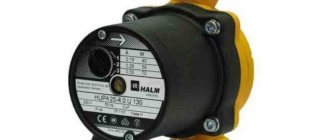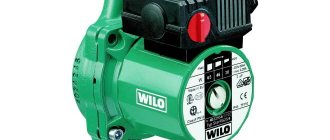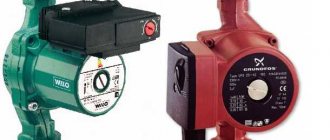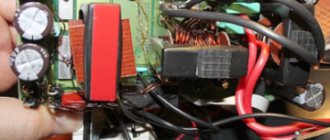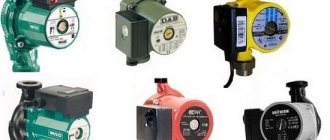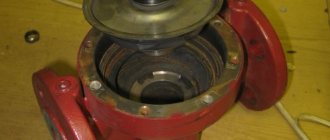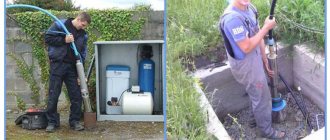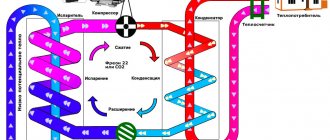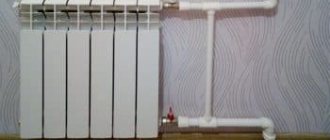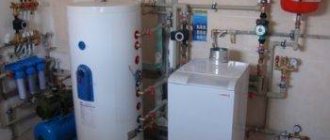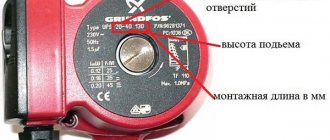- The value of correctly performed calculations
- Features of pump selection
The main task of a circulation pump for a home heating system is to ensure the circulation of coolant in the volume necessary to create and maintain a certain temperature. The productivity and power of such equipment is calculated separately for each case; the volumes of pumped hot water will be different. To determine what the characteristics of the circulation pump for the system should be, you can use a special online calculator that makes it easier to calculate and select equipment for a private home.
How to choose a pump for heating a private house?
Having learned about the principles of operation and selection of various types of pumps for the heating system, many people have a question about what type of units to give preference to.
The heating network may well be equipped with two types of pumping equipment at once - it all depends on its complexity. The circulation model will ensure the movement of water through the system, increasing its efficiency. The injection pump will increase the pressure in some areas. Most often it is installed directly next to the heating boiler. However, a conventional heating system for a private home can completely do without a booster unit. This type of pump is considered narrow-profile and is not used in simple heating systems. It will not be possible to replace a circulation pump with a pressure model - they have completely different tasks and principles of operation. The first sets the coolant in motion by suction and ejection, acting due to centrifugal force. The second has a direct effect on pressure, increasing it.
Therefore, in this case, the “either one or the other” option does not work. Experts will be able to quickly determine whether a booster pump is needed in the heating system, or whether the heating efficiency will be sufficient without it.
Now you know how to choose the right pump for your heating system, but we still recommend turning to professionals. Because only experienced professionals will be able to take into account all the features of the existing system and make the most correct decision!
1. The starting point when choosing a circulation pump for a heating system is the building's heat demand, calculated for the coldest time of year.
In professional design, this indicator is determined on a computer. It can be approximately calculated based on the area of the heated room.
For residential buildings with improved thermal insulation and industrial premises, 30–50 W/sq.m. is required.
— for 1–2-story buildings
– 173 W/sq.m at a design outdoor temperature of –25 degrees C and 177 W/sq.m at –30 degrees C;
— for 3–4-story buildings
– 97 and 101 W/sq.m., respectively.
Using the interpolation method, we find that in Khabarovsk the specific heat demand of 1-2-story residential buildings is 177.8 W/sq.m, and 3-4-story buildings are 101.8 W/sq.m.
2. Having determined the heat consumption (G, W), you should proceed to calculating the required pump performance (supply) using the formula:
Q = G/1.16 x DT (kg/h), where:
D.T.
– the temperature difference in the supply and return pipelines of the heating circuit (in standard two-pipe systems it is 20 degrees C; in low-temperature systems 10 degrees C; for heated floors 5 degrees C);
1,16
– specific heat capacity of water (Wh/kg*deg C). If a different coolant is used, appropriate adjustments must be made to the formula.
This calculation method is offered by foreign designers. The mandatory annex to SNiP 2.04.05-91* provides the following formula:
Q = 3.6 x G/(c x DT) (kg/h), where:
c
– specific heat capacity of water equal to 4.2 kJ/kg*deg C.
3. In addition to the required supply, the pump must provide pressure (pressure) sufficient to overcome the resistance of the pipeline network. To make the right choice, you need to determine the losses in the longest line of the circuit (to the farthest radiator).
Here you can use the formula:
H = (R x l + *Z)/p x g (m), where:
R
– resistance in a straight pipe (Pa/m);
l
– pipeline length (m);
*Z
– resistance of fittings, etc. (Pa);
p
– density of the pumped medium (kg/cub.m);
g
– free fall acceleration (m/sq.s).
Experimentally obtained data indicate that the resistance of straight pipe sections (R) is about 100–150 Pa/m. This corresponds to the required pump pressure of 0.01–0.015 m per 1 m of pipeline. In the calculations, it is necessary to take into account the length of both the supply and return lines.
Specialists from Wilo E. Buscher and K. Walter recommend the following formula for approximate calculation of pressure (in meters):
H = R x l x ZF, where
ZF
– safety factor.
If the installation is equipped with neither a thermostatic valve nor a mixer, ZF = 1.3; for a circuit with a thermostatic valve ZF = 1.3 x 1.7 = 2.2; when the system turns on both devices ZF = 1.3 x 1.7 x 1.2 = 2.6. Using a simplified method, we can consider 2.2 for heating systems, 2.6 for hot water supply.
Operation and care
To extend the service life of pumping equipment in heated floors, during installation, operation and maintenance, a number of rules must be followed:
- Do not tighten the connecting parts tightly, since modern models are made of alloys that do not have great strength. To ensure the tightness of the system, it is not recommended to use tow, but it is better to use modern tapes that can withstand high pressure well, and do not require tight tightening of the connecting nodes.
- Install the device in an accessible place so that in case of breakdown it can be easily replaced. Also, it needs constant preventive maintenance, which consists of inspecting the oil seal. When there are large amounts of impurities in water, they harden and cause damage. These deposits must be removed, and to reduce the amount of their formation it is better to install a filter.
- Bleed the air before starting the system, and prophylactically once a month, by opening a special tap. Air in the line complicates the movement of water, and this provokes the formation of cold spots. At the same time, the automation sends a command to the pump, and it is switched on unexpectedly, thereby starting it more often. This reduces its resource, and accordingly the service life decreases.
- Lubricate the mechanism once a year, especially the “dry” type device.
It is not recommended to suddenly switch pressure or temperature in the system. And when it freezes, or after summer, the temperature should be increased gradually.
In conclusion, we can say that water floors will not function effectively without circulation equipment. It’s up to you to decide which pump to choose for underfloor heating. But if you are not sure that you can install the equipment yourself, it is better to invite professionals.
Let's learn how to select a pump and a three-way pump for a heated floor! Warm floors from A to Z - part 3
Supply (performance) of pumping equipment
This is one of the main factors to consider when choosing a device. Supply – the amount of coolant pumped per unit of time (m3/hour). The higher the flow, the greater the volume of liquid that the pump can pump. This indicator reflects the volume of coolant that transfers heat from the boiler to the radiators. If the supply is low, the radiators will not heat well. If the performance is excessive, home heating costs will increase significantly.
The power of circulation pumping equipment for a heating system can be calculated using the following formula: Qpu=Qn/1.163xDt [m3/h]
In this case, Qpu is the supply of the unit at the design point (measured in m3/hour), Qn is the amount of heat consumed in the area that is heated (kW), Dt is the temperature difference recorded on the forward and return pipelines (for standard systems this is 10- 20°C), 1.163 – indicator of the specific heat capacity of water (if another coolant is used, the formula must be adjusted).
Circulation pump calculation
The flow rate of water circulating in the heating system is proportional to the thermal load and inversely proportional to the temperature curve.
The flow rate of water circulating in the hot water supply system is proportional to the heat losses in the pipelines of the hot water supply system and is inversely proportional to the difference in temperature of the water supplied to the hot water supply system and returned from it.
How to make a mini projector with your own hands
Pressure losses in heating and hot water supply systems are determined by hydraulic calculations and must be included in the design plans for these systems.
When determining the pump pressure, one should not neglect the natural circulation pressure of the system, which arises due to the difference in the densities of hot water at the entrance to the system and cold water at the exit from it. The value of natural pressure has a positive sign if the center of heating of the water is below the center of cooling and negative if the center of heating is above the center of cooling.
During different periods of the heating season, the magnitude of natural pressure is different and, accordingly, its influence is different. The influence of natural pressure can be eliminated by installing automatic differential pressure or flow regulators. The greater the share of natural pressure in the circulation pressure, the greater its influence.
Purpose
The main function of the circulation pump is to ensure optimal pressure in the pipeline so that the circulation of coolant in the line is uninterrupted. This will minimize disruptions in the operation of the warm water floor due to airing of the pipes.
Refusal of the unit in order to save money when constructing heated water floors (in any of the rooms - kitchen, bathroom) will affect the efficiency of their operation.
Main parameters of pumps for heating systems
The main function of circulation-type pumping equipment, which is installed in heating systems, is the effect of the centrifugal force of rotation of the blades located inside the pump body on the liquid in order to increase the speed of its movement. When choosing pumps, the following characteristics are of key importance:
Performance. Using this parameter, you can understand how much coolant can pass through the pumping unit per hour of operation. The unit of measurement is cubic meter per hour, the performance indicator is determined by the hydraulic resistance that the line has; Pressure Otherwise called hydraulic resistance. This parameter affects the maximum height to which the pumping equipment is capable of delivering a column of water; Connection dimensions
When determining them, you should pay attention to such parameters as the diameter of the connected heating pipes and the length of the housing. Typically, the first parameter has a value equal to 25 or 32 mm, and when calculating the second, it is necessary to proceed from the fact that it should allow the pump to be installed in the place that the owner has allocated for it; Maximum temperature. The circulation pumping unit is designed primarily to ensure the supply of heated liquid to all participants in the system
For this reason, it is recommended to be very careful when choosing this parameter and to use a device that can pass coolant through itself heated to a temperature of 110 degrees Celsius; Manufacturer. It is recommended, as when choosing other types of devices, to give preference to products from well-known manufacturers. If we consider the pumping equipment market, the best companies have proven themselves are Grundfos, Vortex, Gileks, Wilo and others.
The circulation pumping unit is designed primarily to ensure the supply of heated liquid to all participants in the system. For this reason, it is recommended to be very careful when choosing this parameter and to use a device that can pass coolant through itself heated to a temperature of 110 degrees Celsius; Manufacturer. It is recommended, as when choosing other types of devices, to give preference to products from well-known manufacturers. If we consider the pumping equipment market, the best companies have proven themselves are Grundfos, Vortex, Gileks, Wilo and others.
Most often, when selecting a pump for a heating system, the first two indicators are taken into account. For the most part, their values are given in the instructions supplied with the device in the form of a graph called the flow-pressure characteristic.
On sale you can find separate models of pumps that provide several operating speeds. If the owner is interested in such a device, then he must make sure that the value ranges are indicated for each of them.
Hydraulic linkage
Balancing pressure drops in the heating system is carried out using control and shut-off valves.
Hydraulic linking of the system is carried out on the basis of:
- design load (coolant mass flow);
- data from pipe manufacturers on dynamic resistance;
- the number of local resistances in the area under consideration;
- technical characteristics of fittings.
Installation characteristics - pressure drop, fastening, throughput - are set for each valve. They are used to determine the coefficients of coolant flow into each riser, and then into each device.
Pressure loss is directly proportional to the square of the coolant flow rate and is measured in kg/h, where
S is the product of dynamic specific pressure, expressed in Pa/(kg/h), and the reduced coefficient for local resistance of the section (ξpr).
The given coefficient ξpr is the sum of all local resistances of the system.
Example as a check
It was previously determined that the building's heat requirement is 45.6 kW, and the coolant flow required for heating is 2.02 cubic meters per hour. The piping diagram to the most distant radiator includes four sections and a heat control valve.
The total pressure losses in them are equal to:
DP = 0.63 + 0.111 + 0.142 + 0.289 = 1.178 m
According to SNiP 2.04.05-91*, 10% should be added to this value for unaccounted pressure losses:
DP = 1.178 x 1.1 = 1.296 m
When calculating using the method outlined in the article, we obtain:
H = 0.015 x (3.2 + 4.4 + 8.9 + 21.7) x 1.3 x 1.7 = 1.266 m,
which is not too different from the value obtained earlier.
Water heating with a special pump required for pumping the coolant is in many ways superior to similar systems with natural circulation of the working environment. The efficiency with the installation of such a device increases significantly. In addition, additional possibilities arise in terms of adjustment. As for the pipelines used, you can choose products with a smaller diameter, and this allows you to create very economical heating networks.
A forced circulation heating system will work properly provided that the performance and some other parameters of the pump are correctly selected. First of all, you should clarify how much coolant the product can pump in a specific period of time.
Initially, it is not advisable to purchase a pump model with a large supply of performance characteristics. Firstly, the cost of the device will be too high, so you will have to spend a significant part of the budget. Secondly, the device will consume excess energy, since as power increases, its consumption also increases.
Last but not least, when choosing, you should take into account the factors of comfort and quality characteristics. For a quiet stay, it is, of course, better to purchase a device that does not create a lot of noise and is durable. These requirements are usually met by products from trusted manufacturers that have been on the market for a long time.
Calculation of circulation pump parameters
Good afternoon to you, my dear reader! I decided to devote this blog post to calculating the necessary parameters of the circulation pump. For those who are not in the know, let me remind you that it is necessary to maintain the movement of fluid (coolant) inside the heating system.
In the vast majority of modern private houses, the heating system cannot be implemented without a pump due to the long length of pipelines and their small diameters. And systems with natural circulation (gravity) have become exotic and are used only for small village houses. So, let's get straight to the point and find out what we will need to calculate.
Calculation of circulation pump flow
Heating system with circulation pump.
Flow - the amount of coolant moved by the circulation pump over a period of time. This parameter is measured in m³/hour or kg/hour. It would seem, why know and count on him? The thing is that the coolant has a limited heat capacity and in order to transfer the required amount of heat through the heating devices a certain volume of coolant must pass. Below is a formula showing this relationship:
L = Q/ρC(t1-t2); where L is the flow rate, Q is the required thermal power of the system, ρ is the density of the liquid, and C is its heat capacity, t1-t2 is the temperature difference between the supply and return pipes of the boiler.
If water is used as a coolant, the formula is simplified:
G = 0.86Q/(t1-t2); where G is the mass flow rate of water, measured in kg/hour.
Another parameter related to flow rate is the diameter of the threads on the nuts. For the most common glandless pumps, there are two options: 1 inch (DN 25) and 1¼ inches (DN 32). Take this point into account when designing to avoid unnecessary rework during installation.
Nuts for circulation pump.
Calculation of the required pressure of the circulation pump
The pressure is the height to which the circulation pump can theoretically raise the liquid (the unit of measurement is meter of water column). In fact, the rated pressure value is the limit at which the pump stops providing coolant movement (flow rate becomes zero). To simplify the calculation of the required pressure of the circulation pump, you can use the formula:
H=k*Δpav; where k is the number of floors of the house, Δpav is the average pressure value, approximately equal to 0.9 meters.
For an accurate calculation, you will need to familiarize yourself with the methodology for calculating hydraulic losses, which is outlined in another article.
Determination of the pump operating point.
The figure shows two intersecting characteristics, one of which shows the change in pressure of the circulation pump depending on its flow rate (red), and the second shows how quickly the hydraulic resistance of the heating system increases with increasing fluid flow through it. You need to select a pump so that the parameters calculated above correspond to the values at the operating point or are slightly larger. If there is a significant deviation upward or downward, you will get either cavitation noise or poor circulation.
Selection of a circulation pump for water heated floors
To operate a water heated floor, you also need a circulation pump, which is installed in an autonomous circulation group (also called a mixing unit). Its parameters are selected so that at its operating point the pressure necessary to overcome the hydraulic resistance of the floor circuits, the mixing valve and all other parts of the system is provided.
The flow rate is the same - it must ensure the transfer of the required amount of thermal energy from the floor. In most cases, water-heated floors are used together with radiators or convectors, so this amount does not necessarily have to cover the heat losses of the room.
I suggest you watch the following video to see how a circulation pump for heated floors is selected in practice:
What factors influence the determination of power
To determine accurate data, absolutely all the subtleties of the thermal design are taken into account, but most importantly, you need to generally understand what function is required of it:
Any circulation pump has only 2 tasks:
- ensuring sufficient water pressure to overcome hydraulic resistance;
- forced injection of coolant velocity, which is sufficient to move throughout the entire heating system at an equal temperature.
Accordingly, knowing its functions, you need to understand what its productivity is (the volume of water distilled within an hour) and pressure (the speed of overcoming hydraulic resistance).
But the most important point that must be taken into account when calculating pump performance for a heating system is the type of unit itself.
Manufacturers distinguish two types:
With dry rotor
The design of such devices eliminates contact of the blades with the coolant. This allows you to pump significantly larger volumes of water than the second version of the pumping device. In addition, such models can be easily retrofitted with a more highly efficient engine, which will increase the volume of pumped coolant, without replacing the pumping station itself.
With wet rotor
The blades of the unit are completely submerged in water. The use of such devices is characterized by the absence of the need to lubricate the elements, as well as quiet operation. And all because the lion's share of the noise produced by the equipment is absorbed by water. But at the same time, such devices quickly become unusable due to wear and tear of components.
As a rule, the first option is used in industrial premises, while the second is used to create the required level of injection in relatively small structures. In addition, there are also mini pumping stations that can be used to equip country houses or small units.
These, in fact, are the characteristics of circulation pumps for heating, according to which you can choose an installation for piping the heating unit. Let's move on to a detailed consideration of how to calculate the power of a circulation pump for heating.
How to calculate hardware performance
Before calculating a heating pump, you should select the operating point for the location of equipment of a similar design. Simply put, it is necessary to determine the location of the device where it will connect to the heating main. It is placed in the same place.
As a rule, such units are connected to the return line. However, if you connect it to the supply pipe, then there will be no error. Moreover, this will in no way affect the efficiency of the heating circuit.
System layout
When calculating the pump power, it is better to give preference to the option in which the performance of its initial point will be equal to the throughput consumed directly by the heating unit itself. Often, professionals recommend piping the thermal circuit with more powerful equipment in case of unforeseen situations. However, if you do not plan to expand the area of the heated room, then there is no need for a heavy-duty unit.
The principle of operation of circulation pumps
The task that circulation pumps are designed to perform for heating private houses is relatively simple. By creating excess pressure in the pipes with the coolant, the unit forces it to circulate, thereby ensuring the delivery of the required amount of thermal energy to all rooms of the house. The presence of such a supercharger allows not only to reduce the diameters of the heating circuit pipes, but also to lay them in the most convenient way and even taking into account the features of the interior.
Currently, there are the following types of circulation pumps:
- with dry rotor;
- with a wet rotor.
A dry rotor pump is a conventional electric motor with an impeller mounted on its shaft, housed in a sealed housing. That is, in this unit the pumping unit and the drive are located separately and, of course, the electric motor rotor does not come into contact with the coolant in any way. Due to their characteristics, these blowers are used where significant circulation pump power is needed - in heating networks of industrial enterprises or centralized boiler houses of various institutions and organizations.
Powerful circulation pumps for heating systems with a separate drive are distinguished by their impressive dimensions and high noise level, which makes their use in private housing construction impossible. In individual systems, units with a wet rotor are installed, which are very small in size and make virtually no noise during operation. In these pumping devices for home heating, the drive and impeller are combined in one housing. To seal, the rotor is encased in a stainless steel shell and placed inside a sleeve made of the same material. The sleeve protects the stator of the unit from moisture, the entire structure is shown in the figure:
A little about the manufacturers. One of the most popular brands is German WILO circulation pumps. Over the years of operation, they have proven themselves to be the best. The manufacturer offers several lines of units of varying power and set of functions
So when choosing a brand of pumps, you should first pay attention to this brand. GRUNDFOS pumps are also widely used, but their quality is a little worse
What room requirements must be met when installing the system?
During installation work, the most correct decision would be when the pipeline is installed at the initial stage of construction of the floors. This method is 30–40% more economical than the radiator method
It is also possible to install a water heating structure in a ready-made room, but to save the family budget, you should pay attention to the following requirements:
- The height of the ceilings should allow the installation of heated floors with a thickness of 8 to 20 centimeters.
- The height of doorways should not be less than 210 centimeters.
- To install a cement-sand screed, the floor must be more durable.
- To avoid airiness of the contours and high hydraulic resistance, the surface for the base of the structure must be flat and clean. The permissible level of unevenness is no more than 5 millimeters.
And also in the building itself or in individual rooms where the heating system will be installed, plastering work must be done and all windows must be installed.
Pressure calculation
If a circulation pump is installed during the installation of the main heating equipment, there is a need to calculate the pressure relative to the specified apparatus. This activity is carried out using the following formula:
H=(R*L +Z')/p*g.
Here are the following quantities and values:
R is the resistance indicator relative to the straight section of the pipeline.
L is the length of the pipeline itself.
Z - resistance caused by various obstacles present in the path of the circulating substance (fittings, fittings).
p is an indicator of the density of the coolant at a specific temperature.
g is an indicator of acceleration relative to free fall.
When calculating a pump installed in an already functioning heating system, approximate data are used:
H=R*L*ZF
The following parameters are present here:
R is the resistance of a straight pipe. The approximate value of this value is 100-150 Pascal per meter. It should be displayed in pressure readings. Then it will take the following form: 0.010-0.015 meters per meter of pipeline.
In this case, you need to start from the maximum value. Such actions will not have a negative impact on energy consumption.
L is the total length of the pipes. If we are talking about a two-pipe heating system, the duration of the supply circuit and the return circuit should also be taken into account.
ZF is a multiplication factor that greatly simplifies the process of performing calculation operations. Its meaning depends on the following circumstances:
- if the system is equipped with conventional ball valves that prevent a decrease in clearance, as well as fittings with appropriate dimensions, the multiplication factor is 1.3;
- when the system contains a throttle or thermostatic regulator that breaks the circuit, an additional value of 1.7 is applied;
Calculation example
If the total area of a square room is 150 m2, then the length of each wall will be 12.25 meters. Consequently, the total length of the pipeline is quite simple to calculate: 12.25 must be multiplied by 4, the result is 49 meters.
It is worth noting that the chokes are mounted directly on heating devices. In this case, rupture of the main ring should be completely excluded.
By substituting the available values into the appropriate formula, you can determine the desired pressure:
0,015*49*1,3=0,9555.
It is important to note that the purchased circulation pump must have a headroom reserve, the value of which is at least ten percent. A circulation pump is a mandatory element of a water heating system for a house with forced or combined (combined) circulation
And in order for it to work effectively, it is necessary to choose the right model with the most suitable characteristics. From this article you can learn how to independently select a circulation pump for a heating system
A circulation pump is a mandatory element of a water heating system for a house with forced or combined (combined) circulation. And in order for it to work effectively, it is necessary to choose the right model with the most suitable characteristics. From this article you can learn how to independently select a circulation pump for a heating system.
A few additional tips
Longevity is largely influenced by the materials from which the main parts are made. Preference should be given to pumps made of stainless steel, bronze and brass. Pay attention to what pressure in the system the device is designed for.
Although, as a rule, there are no difficulties with this (10 atm is a good indicator). It is better to install the pump where the temperature is minimal - before entering the boiler. It is important to install a filter at the entrance. It is advisable to position the pump so that it “sucks” water from the expander. This means that the order in the direction of water movement will be as follows: expansion tank, pump, boiler.
Conclusion
So, in order for the circulation pump to work for a long time and conscientiously, you need to calculate its two main parameters (pressure and productivity).
You should not strive to comprehend complex engineering mathematics.
At home, an approximate calculation will be enough. All resulting fractional numbers are rounded up.
Number of speeds
To control (switch gears), a special lever on the unit body is used. There are models that are equipped with a temperature sensor, which allows you to fully automate the process. To do this, you do not need to manually switch speeds; the pump will do this depending on the room temperature.
This technique is one of several that can be used to calculate pump power for a specific heating system. Specialists in this field also use other calculation methods that allow them to select equipment based on power and pressure created.
Many owners of private houses may not try to calculate the power of the circulation pump for heating, since when purchasing equipment, as a rule, specialist assistance is offered directly from the manufacturer or a company that has entered into an agreement with the store.
When choosing pumping equipment, it should be taken into account that the necessary data for carrying out calculations must be taken from the maximum that the heating system can, in principle, experience. In reality, the load on the pump will be less, so the equipment will never experience overload, which will allow it to work for a long time
But there are also disadvantages - higher electricity bills.
But on the other hand, if you choose a pump with less power than required, then this will not affect the operation of the system in any way, that is, it will operate normally, but the unit will fail faster. Although your electricity bill will also be lower.
There is one more parameter by which you should choose circulation pumps. You may notice that in the assortment of stores there are often devices with the same power, but with different dimensions.
You can calculate the heating pump correctly, taking into account the following factors:
- 1. To install equipment on conventional pipelines, mixers and bypasses, you need to select units with a length of 180 mm. Small devices 130 mm long are installed in hard-to-reach places or inside heat generators.
- 2. The diameter of the supercharger pipes should be selected depending on the cross-section of the main circuit pipes. At the same time, it is possible to increase this indicator, but it is strictly forbidden to decrease it. Therefore, if the diameter of the main circuit pipes is 22 mm, then the pump pipes should be 22 mm and above.
- 3. Equipment with a pipe diameter of 32 mm can be used, for example, in heating systems with natural circulation for its modernization.
What else influences the choice
The selection of a pump for a heating system, in addition to its basic parameters (pressure and flow), can be influenced by some other factors, for example, such as: manufacturer, workmanship, durability, maximum operating temperature, cost, etc. They are often related. High-quality pumps from reliable ones, "Wilo", "DAB", "Lowara", "Ebara" and "Pedrollo", usually have a high cost. Chinese or domestic models are usually much cheaper, but there is no guarantee of their reliability and long-term operation. Here everything depends on personal choice: either a high-quality, reliable product at a higher price or a cheaper, but less reliable circulation pump, which may have to be changed soon. Sometimes, to save money, they buy used Grundfos or Wilo. Often, they work normally longer than new Chinese ones, but if purchased from trusted specialists who can give a certain guarantee.
Another technical characteristic parameter that may be important when choosing a circulation pump is the maximum permissible operating temperature, which should also be in its passport or operating instructions. This is especially important if the pump is supposed to be installed in a heating system with a solid fuel boiler on the supply pipe. The maximum permissible temperature for its operation, in this case, should be at least 110 o C. If, however, it is installed on the return line, then this parameter is not so important, since the coolant temperature in this place rarely exceeds 70 o C.
The heating system in a private or country house needs a special pump that will help the coolant circulate through the pipes. Thanks to this circulation pump, it is possible to ensure that all rooms in the house are heated in the most uniform manner. Installing such a device requires some calculations. The calculation of a heating pump may depend on some specific circumstances. First, you need to decide on the type of pump. The pump can be “wet” or “dry”. Their difference is that the first pump has a working area under a layer of water, that is, in the pumped medium.
This pump does not require additional lubrication or moisturizing. However, it must be taken into account that water pressure or resistance can largely influence the functional power of the unit. Let's figure out how to calculate a heating pump.
